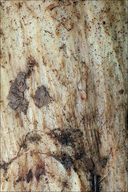|
|
click photo for larger file

Hemileccinum impolitum
Iodine Boletus
|
Photographer: Dr. Amadej Trnkoczy
ID: 0000 0000 0918 2899 (2018-09-22)Copyright © 2018 Dr. Amadej Trnkoczy
|
|
INFORMATION PROVIDED WITH THE PHOTO
|
date of photo Sep 19, 2018
latitude 46.36046 longitude 13.69313
View on Google Maps.
location
Lower Trenta valley, between villages Soča and Trenta, right bank of river Soča; next to the trail from Soča 46 abandoned farm house to Planina Na skalah, just before the trail passes a sandy ravine, East Julian Alps (Posočje, Slovenia)notes Slo.: preprosti goban - syn: Boletus impolitus Fr., Leccinum impolitum (Fr.) Bertault, Xerocomus impolitus (Fr.) Quél. - Habitat: old stands of Fagus sylvatica wood with scattered Picea abies, no Quercus sp. in the vicinity; steep mountain slope, southeast aspect; calcareous ground; shallow, skeletal, presumably locally somewhat acid soil (growing among Erica carnea), no clay present; half shade; dry and relatively warm place; partly protected from direct rain by tree canopies; average precipitations ~ 3.000 mm/year, average temperature 5-7 deg C, elevation 885 m (2.900 feet), alpine phytogeographical region. - Substratum: soil. - Comments: Hemileccinum impolitum is a beautiful, all yellowish bolete, generally considered a rare find in Europe. However, this doesn't seem to hold for Slovenia, since many records exist in Boletus Informaticus Data Base (Ref.7). The species is very similar to closely related Hemileccinum depilatum (Redeuilh) Šutara. The most important distinguishing traits are pilei surface and microscopic structure of pilei cutis. The latter species usually looks like having 'hammered' pileus. However, the only sure way to differentiate them is microscopic structure of their pilei cuticle. Hemileccinum depilatum has hymeniform-cellular cuticle with many club shaped to sub globose end cells. I found nothing like this in this find. - Growing solitary. Hut diameter 12 cm, stipe 12.5 cm long and almost 4 cm wide (max); hut somewhat sticky; strong smell on chemicals in the stipe base (which almost disappears after several hours), otherwise smell of trama and pore layer quite mild; taste mild, pleasant; no part of the pileus is bruising when cut or damaged; SP abundant, olive-beige, oac847. Spores smooth. Dimensions: (11.5) 12.1 - 13.9 (14.5) × (5.1) 5.3 - 5.8 (6.1) µm, Q = (2) 2.2 - 2.5 (2.7); N = 33; Me = 13 × 5.5 µm; Qe = 2.3; Olympus CH20, NEA 100x/1.25, magnification 1.000 x, oil in water, fresh material. AmScope MA500 digital camera. Herbarium: Mycotheca and Herbarium of Slovenian Forestry Institute, Večna pot 2, Ljubljana, Slovenia, Index Herbariorum acronym LJF Ref.: (1) https://boletales.com/genera/boletus/b-impolitus/ (accessed Sept. 20. 2018) (2) J. Breitenbach, F. Kraenzlin, Eds., Fungi of Switzerland, Vol.3. Verlag Mykologia (1991), p 56. (3) G.J. Krieglsteiner (Hrsg.), Die Grosspilze Baden-Württembergs, Band 2., Ulmer (2000), p 226. (4) M. Bon, Parey's Buch der Pilze, Kosmos (2005), p 36. (5) http://www.gobe.si/Gobe/BoletusImpolitus (accessed Sept. 22. 2018) (6) R. Phillips, Mushrooms, Macmillan (2006), p 278. (7) N. Ogris (ed), Boletus informaticus, Slovenian Forestry Institute http://www.zdravgozd.si/bi_index.aspx (accessed Sept. 22. 2018)camera Nikon D700 / Nikkor Micro 105mm/f2.8
contributor's ID # Bot_1157/2018_DSC3305 photo category: Fungi - fungi
|
MORE INFORMATION ABOUT THIS FUNGUS
|
| common names
Iodine Boletus (photographer)
View all photos in CalPhotos of Hemileccinum impolitum Check Google Images for Hemileccinum impolitum |
|
The photographer's identification Hemileccinum impolitum has not been reviewed. Click here to review or comment on the identification. |
|
Using this photo The thumbnail photo (128x192 pixels) on this page may be freely used for personal or academic purposes without prior permission under the Fair Use provisions of US copyright law as long as the photo is clearly credited with © 2018 Dr. Amadej Trnkoczy.
For other uses, or if you have questions, contact Dr. Amadej Trnkoczy amadej.trnkoczy[AT]siol.net. (Replace the [AT] with the @ symbol before sending an email.) |
|
|
